
The history of Greenland is a history of life under extreme Arctic conditions: currently, an ice sheet covers about eighty percent of the island, restricting human activity largely to the coasts. The first humans are thought to have arrived in Greenland around 2500 BCE. Their descendants apparently died out and were succeeded by several other groups migrating from continental North America. There has been no evidence discovered that Greenland was known to Norsemen until the ninth century CE, when Norse Icelandic explorers settled on its southwestern coast. The ancestors of the Greenlandic Inuit who live there today appear to have migrated there later, around the year 1200, from northwestern Greenland.

Leif Erikson, also known as Leif the Lucky, was a Norse explorer who is thought to have been the first European to set foot on continental America, approximately half a millennium before Christopher Columbus. According to the sagas of Icelanders, he established a Norse settlement at Vinland, which is usually interpreted as being coastal North America. There is ongoing speculation that the settlement made by Leif and his crew corresponds to the remains of a Norse settlement found in Newfoundland, Canada, called L'Anse aux Meadows, which was occupied approximately 1,000 years ago.
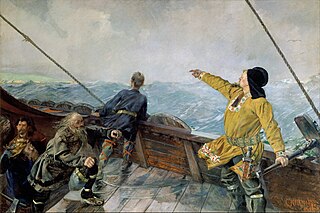
The Norse exploration of North America began in the late 10th century, when Norsemen explored areas of the North Atlantic colonizing Greenland and creating a short term settlement near the northern tip of Newfoundland. This is known now as L'Anse aux Meadows where the remains of buildings were found in 1960 dating to approximately 1,000 years ago. This discovery helped reignite archaeological exploration for the Norse in the North Atlantic. This single settlement, located on the island of Newfoundland and not on the North American mainland, was abruptly abandoned.
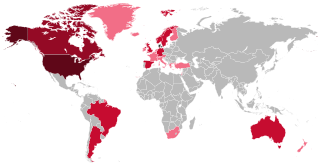
Danes, or Danish people, are an ethnic group and nationality native to Denmark and a modern nation identified with the country of Denmark. This connection may be ancestral, legal, historical, or cultural.
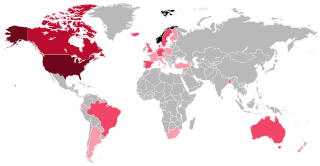
Norwegians are an ethnic group and nation native to Norway, where they form the vast majority of the population. They share a common culture and speak the Norwegian language. Norwegians are descended from the Norse of the Early Middle Ages who formed a unified Kingdom of Norway in the 9th century. During the Viking Age, Norwegians and other Norse peoples conquered, settled and ruled parts of the British Isles, the Faroe Islands, Iceland and Greenland. Norwegians are closely related to other descendants of the Norsemen such as Danes, Swedes, Icelanders and the Faroe Islanders, as well as groups such as the Scots whose nation they significantly settled and left a lasting impact in, particularly the Northern Isles.

Icelanders are an ethnic group and nation who are native to the island country of Iceland. They speak Icelandic, a North Germanic language.
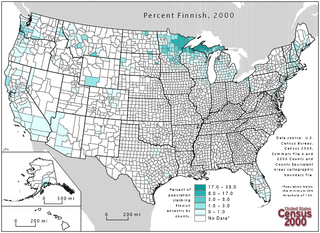
Finnish Americans comprise Americans with ancestral roots in Finland, or Finnish people who immigrated to and reside in the United States. The Finnish-American population is around 650,000. Many Finnish people historically immigrated to the Upper Peninsula of Michigan and the Iron Range of northern Minnesota to work in the mining industry; much of the population in these regions is of Finnish descent.

Norwegian Americans are Americans with ancestral roots in Norway. Norwegian immigrants went to the United States primarily in the latter half of the 19th century and the first few decades of the 20th century. There are more than 4.5 million Norwegian Americans, according to the 2021 U.S. census; most live in the Upper Midwest and on the West Coast of the United States.

Icelandic Canadians are Canadian citizens of Icelandic ancestry, or Iceland-born people who reside in Canada.
Nordic and Scandinavian Americans are Americans of Scandinavian and/or Nordic ancestry, including Danish Americans, Faroese Americans, Finnish Americans, Greenlandic Americans, Icelandic Americans, Norwegian Americans, and Swedish Americans. Also included are persons who reported 'Scandinavian' ancestry on their census. According to 2021 census estimates, there are approximately 9,365,489 people of Scandinavian ancestry in the United States.
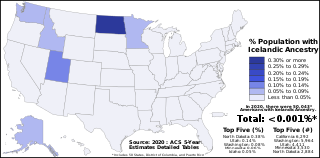
Icelandic Americans are Americans of Icelandic descent or Iceland-born people who reside in the United States. Icelandic immigrants came to the United States primarily in the period 1873–1905 and after World War II. There are more than 40,000 Icelandic Americans according to the 2000 U.S. census, and most live in the Upper Midwest. The United States is home to the second largest Icelandic diaspora community in the world after Canada.
Norwegian Canadians refer to Canadian citizens who identify themselves as being of full or partial Norwegian ancestry, or people who emigrated from Norway and reside in Canada.
Nordic colonialism is a subdivision within broader colonial studies that discusses the role of Nordic nations in achieving economic benefits from outside of their own cultural sphere. The field ranges from studying the Sámi in relation to the Norwegian, Swedish and Finnish states, to activities of the Danish Colonial Empire and Swedish Empire in Africa, New Sweden, and on Caribbean islands such as St. Thomas and Saint-Barthélemy.
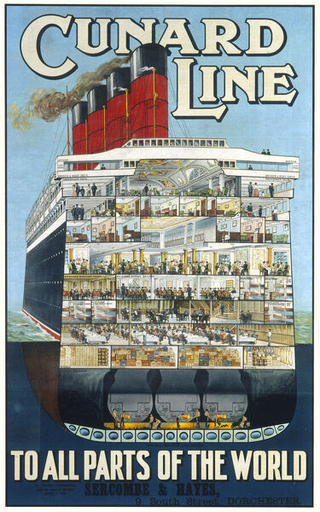
During the 19th and early 20th centuries, about 1.3 million Swedes left Sweden for the United States of America. While the land of the American frontier was a magnet for the rural poor all over Europe, some factors encouraged Swedish emigration in particular. Religious repression and idiosyncrasy practiced by the Swedish Lutheran State Church was widely resented, as was social conservatism and snobbery influenced by the Swedish monarchy. Population growth and crop failures made conditions in the Swedish countryside increasingly bleak. By contrast, reports from early Swedish emigrants painted the American Midwest as an earthly paradise.
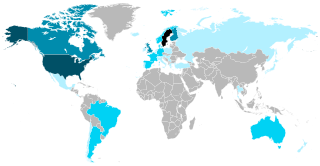
The Swedish diaspora consists of emigrants and their descendants, especially those that maintain some of the customs of their Swedish culture. Notable Swedish communities exist in the United States, Argentina, Australia, Canada, New Zealand, Brazil, and the United Kingdom as well as others.
The Nordic diaspora may refer to:

Greenlandic independence is a political ambition of some political parties, advocacy groups, and individuals of Greenland, an autonomous territory within the Kingdom of Denmark, to become an independent sovereign state.
The Kashubian diaspora resulted from the emigration of Kashubians mainly in two waves occurring in the second half of the 19th century. The majority of Kashubian emigrants settled in the United States; others emigrated to Canada and Brazil. An online genealogical project, "The Great Kashubian Migration," is devoted to tracking their settlement patterns. Their reasons for emigration varied. Until the Franco-Prussian War, Kashubians emigrated primarily for economic reasons. After the Franco-Prussian War and especially due to the Kulturkampf, Kashubian emigration accelerated as socio-political factors came into play. In his 1899 book, Statystyka ludnosci kaszubskiej, the Kashubophile linguist and sociologist Stefan Ramult estimated that 130,700 Kashubians were living in the Americas.
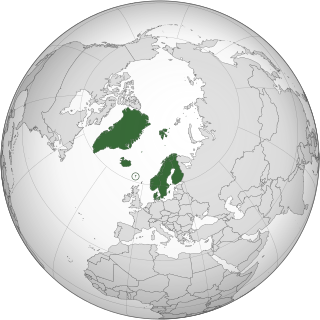
Nordic immigration to North America encompasses the movement of people from the Nordic countries of Sweden, Denmark, Norway, Iceland, and Finland to the North America, mainly the United States and Canada, from the 17th to the 20th centuries. These immigrants were drawn to the New World by factors ranging from economic opportunities to religious freedom and challenges in their native lands. Their legacy has significantly shaped the cultural, social, and economic landscape of the Americas.



















